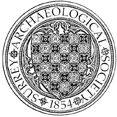St Nicholas’ Church, Shepperton
Evaluation and watching brief by J Stevenson of SCAU, on behalf of the church, of part of the site for a proposed extension. The trenches were restricted to the area outside the churchyard; they revealed considerable disturbance, presumed to represent landscaping in the 19th century. The watching brief on remedial works on the east end of the Chancel revealed the foundations to be constructed from mortared chalk rubble, sitting on the natural gravel, with no obvious signs of earlier structural remains. A number of both articulated and disarticulated human remains were also revealed.


